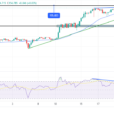In the third quarter 10-Q from Capital One, the bank notes a rather large change in funding. At the start of the year, Capital One had drawn $17.72 billion in advances from the Federal Home Loans Banks (which of the twelve isn’t stated and it is likely there were funding agreements with several). The FHLB system allows banks to pledge collateral in order to receive these advances as one subsidized method of funding bank assets, primarily residential or commercial mortgage loans. That balance was safely less than the overall standby borrowing capacity for Capital One of $29.5 billion.
By the end of Q3, however, the bank had repaid some $13 billion of the advances. Some of that gap was funded by a net increase of $3 billion in longer-term debt. The bulk was transitioned by interest-bearing deposits which rose by $7 billion, leaving the rest funded when the bank issued another $4 billion securitized debt obligations. The latter are securitization tranches of various forms likely on the bank’s credit card trusts that were consolidated years ago under FAS 166/167 (post-crisis).
In Table 30 of Capital One’s SEC filing, the bank suggests the reasons for the rejiggered accounting as perhaps relating to the current phase-in of Basel III’s Liquidity Coverage Ratio (LCR). We are not privy to the calculations, but a major part of the numerator is FHLB drawing capacity. Again, at $29.5 billion in what could be secured (after generous haircuts) at FHLB, Capital One had “only” $11.8 billion available potential liquidity to start the year. The LCR phased effect was to be 80% effective on January 1, 2015, but 90% of the final rule by January 2016 (and 100% January 2017). Reducing the outstanding advances allowed the bank increased its liquidity potential, satisfying a larger LCR standard, via untapped FHLB advances of $23.6 billion (the difference remaining being a lower advance ceiling by September 30).
It also required the shift in overall funding mix as noted above, which included a healthy increase in potential interest cost via those interest-bearing deposits (which had not impacted the bank’s profits by the end of Q3) and a real increase in interest expense due to “other borrowings.” The first nine months of 2015 cost the bank $241 million in interest on “other borrowings” compared to $226 million in the same period of 2014 ($82 million in Q3 2015 alone vs. $71 million in Q3 2014).
What was interesting was that the moves by Capital One were opposite the general trend in FHLB activity overall. Total advances made by the consolidated FHLB system actually grew by about $21 billion from the start of 2015 to the end of Q3; from $570.7 billion to $591.5 billion. The FHLB system gets its funding for these advances by issuing its own debt, one form of the agency class. There was a reported $858 billion in FHLB debt outstanding at the end of Q3, up about $10 billion from $848 billion at the start of 2015. The rest of that increase in advances was made up through FHLB’s asset side, with Held-to-Maturity securities declining by $10 billion to $95 billion (bonds in the portfolio that matured and were not rolled into new bond positions) and a reduction in cash and deposit balances with banks of a further $9 billion. Between the increase in debt liabilities and the decreases in the bond portfolio and cash and equivalents, that left more than enough to fund the $21 billion uptick in outstanding advances. Whatever was remaining after all that was placed in the money markets; about $4.1 billion.












Leave A Comment